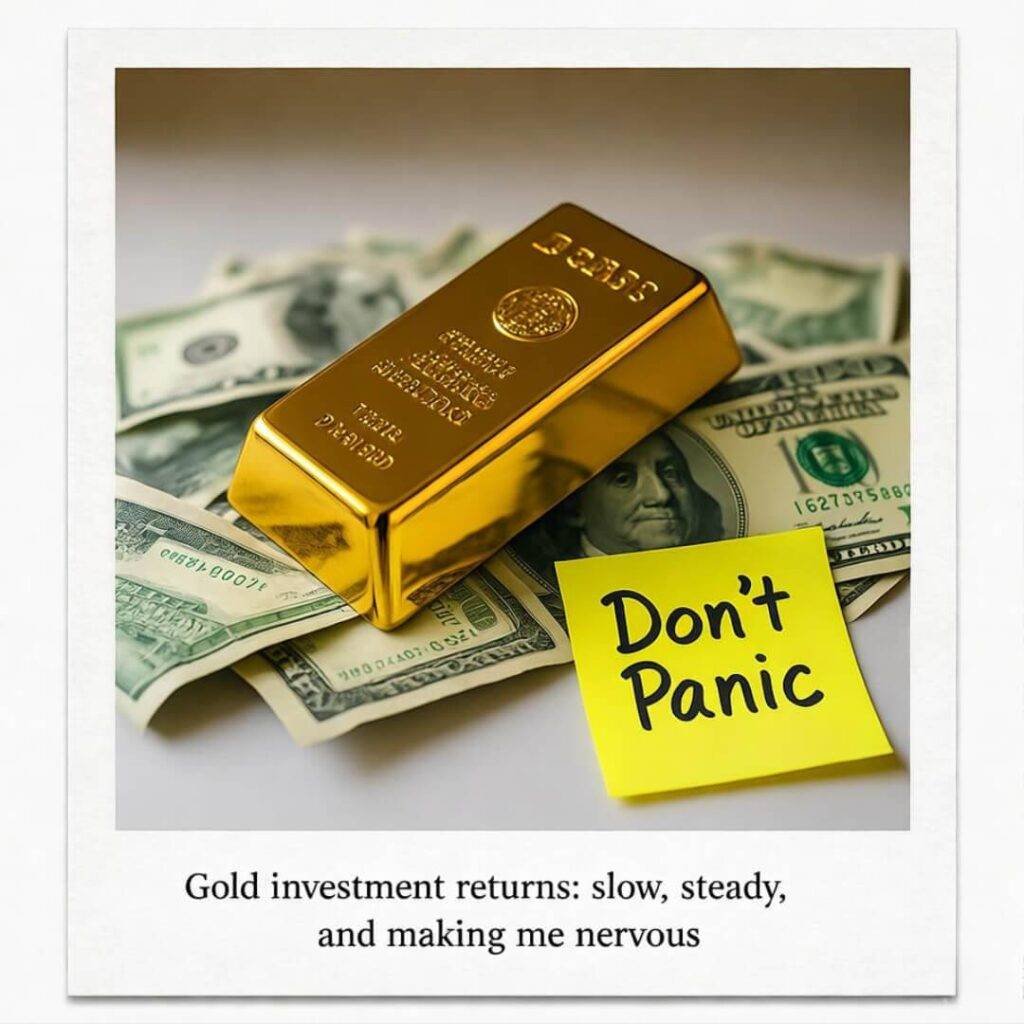Gold investment returns? Yo, they sucked me in hard, like a late-night infomercial, back when I was crashed on my lumpy couch in Philly, the radiator clanking like it was possessed. I’m no Wall Street hotshot—my wallet’s more “broke college kid” than “billionaire vibes.” But gold, man, it’s got this glow, right? Like, it’s been money forever. I was fiddling with this fake gold ring my cousin gave me, thinking, “If this was real, I’d be ballin’.” Newsflash: it wasn’t, and my first go at gold investing? Total faceplant.
I jumped in after skimming some post on X about gold beating inflation, then clicked around on Investopedia. Bought some shares of a gold ETF—SPDR Gold Shares, I think—on my glitchy phone app. Picture me, surrounded by empty takeout containers, the smell of greasy lo mein in the air, my cat swiping at my phone as I hit “buy.” I was hyped for those gold investment returns, like I was gonna be Scrooge McDuck swimming in coins.
H2: So, What’s the Deal with Gold Investment Returns?
Real talk: gold investment returns ain’t gonna make you Jeff Bezos. Historically, gold’s chugging along at like 5-6% a year, per GoldHub. Not terrible, but not exactly crypto-level crazy. I remember checking my ETF last winter, sprawled on my bed with the Philly wind howling outside, and seeing a pathetic 2% gain after months. My stomach dropped faster than my phone’s battery. Like, really? That’s it?
Here’s the lowdown, based on my screw-ups:
- Long game’s where it’s at: Gold’s solid when the economy’s a mess—like during the 2008 crash, it spiked while stocks ate dirt (MarketWatch).
- Short-term? Yawn: Gold prices can bounce like my neighbor’s annoying bassline. In 2024, it hit $2,100 an ounce, then tanked 8% in a month. Wild ride.
- Fees suck: ETFs got expense ratios, and physical gold’s got storage costs. I got hit with a 0.5% fee on my ETF—didn’t even notice ‘til it ate my returns.

H2: My Dumbest Gold Investment Returns Mistakes
Oh god, I’ve got stories. I’m writing this in a dive bar in Philly, the jukebox blaring some 80s tune, and the smell of stale beer’s bringing back memories of my gold investing flops. Once, I got suckered into buying “rare” gold coins online—overpaid by like 15% ‘cause I didn’t check Kitco for real prices. They showed up, and I’m unwrapping ‘em in my kitchen, the sink dripping like it’s mocking me, and I realize I got played. The coins were real, but the price? Highway robbery.
Another time, I tried to “time” the market—sold my ETF shares when gold dipped, thinking I was a genius. Spoiler: it shot up a week later. I was pacing my tiny apartment, the floor creaking, cursing myself while my neighbor’s dog barked like it agreed. Gold investment returns don’t reward impatience, trust me.
H3: Tips from My Gold Investment Returns Disasters
Here’s what I’ve learned, mostly by screwing up:
- Check the fees, dummy: ETFs like GLD got expense ratios—mine was 0.4%. Look it up on Morningstar before you buy.
- Physical gold’s a pain: Storage and insurance costs? Nope. I bailed after pricing it out.
- Don’t go all-in: I keep some cash in stocks and bonds ‘cause I’m not that crazy.

H2: Are Gold Investment Returns Worth It in 2025?
So, is investing in gold worth it right now? I’m nursing a cheap beer, the bar’s sticky floor under my sneakers, and I’m legit torn. Gold’s a safe bet when the world’s on fire—think recessions or when the Fed does something nuts (Reuters). My ETF’s up 9% since I started, which beats inflation but ain’t buying me a penthouse. I kinda dig the stability, but man, it’s slow—like waiting for my landlord to fix the heat.
If you’re like me—skeptical, a little reckless—gold’s worth a peek. Just don’t expect it to make you rich by next Tuesday. It’s more like that reliable friend who’s always there but kinda boring.

H2: Wrapping Up My Gold Investment Returns Ramble
Alright, I’m done, the bar’s getting loud, and I’m pretty sure I spilled beer on my phone. Gold investment returns? They’re chill, not thrilling. I’ve learned to relax, check Bloomberg for prices, and not fall for shiny scams. My advice? Start small with an ETF, don’t go nuts. Got thoughts? Hit me up on X—I’m @GrokRando, probably stressing over my portfolio again.




